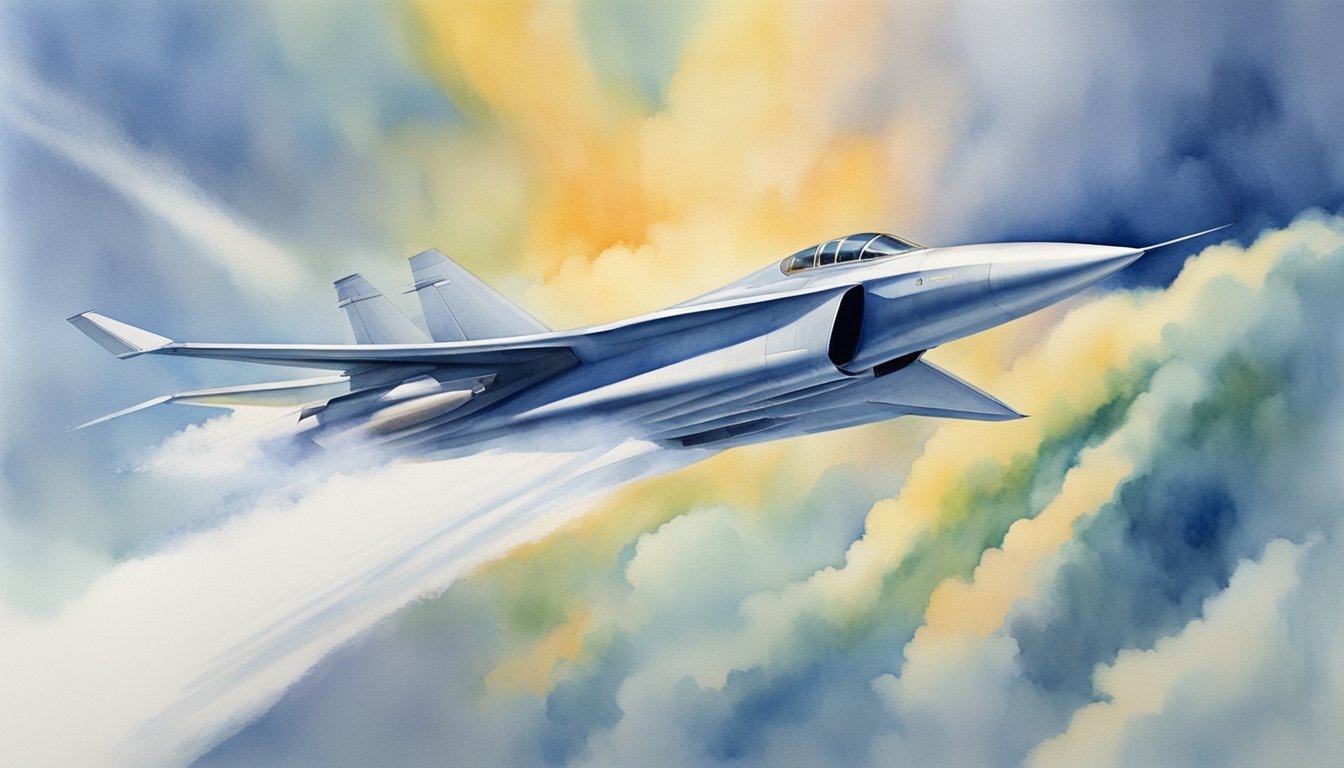Breaking the Sound Barrier
When aircraft exceed the speed of sound, they break the sound barrier, creating a sonic boom. This phenomenon was once thought to be an insurmountable flying obstacle.
History and Milestones
The journey to breaking the sound barrier is marked by pivotal moments and notable figures. On October 14, 1947, Chuck Yeager, a test pilot for the United States Air Force, made history in his aircraft, the Glamorous Glennis. Yeager flew faster than the speed of sound, reaching Mach 1, and pierced through the so-called “sound barrier”. This breakthrough moment was a tribute not just to Yeager’s skill, but also to the advancements in jet-powered aircraft design.
Key Milestones in Breaking the Sound Barrier:
- 1947: Chuck Yeager breaks the sound barrier in the Glamorous Glennis.
- 1969: Concorde, a turbojet-powered supersonic passenger airliner, makes its first test flight, demonstrating the possibility of commercial supersonic travel.
Physics of Supersonic Speed
Understanding the physics behind supersonic speed is crucial to grasp how the sound barrier can be broken. Sound waves are like ripples that travel through air at a certain speed, which at sea level under standard conditions is approximately 343 meters per second. Crossing this speed, jets enter the realm of supersonic flight, marked by the creation of shock waves and sonic booms. The term “Mach 1” is used to describe the speed of sound, and it’s named after Ernst Mach, the Austrian physicist who studied the dynamics of gases and waves.
What Happens When Breaking the Sound Barrier:
- Shock Waves: When an aircraft reaches the speed of sound, it sends out shock waves, causing a dramatic increase in aerodynamic drag.
- Sonic Boom: The sonic boom is the loud noise associated with the shock waves created when an object travels through the air faster than the speed of sound.
The Science of Supersonic Flight
When an aircraft exceeds the speed of sound, it enters the realm of supersonic flight. This speed is often referred to in terms of Mach numbers, where Mach 1 is the speed of sound itself.
Aerodynamics and Speed
Supersonic flight involves complex aerodynamics as air reacts differently at speeds exceeding Mach 1. Higher speeds significantly increase drag forces on an aircraft, which are much greater than those experienced at subsonic speeds. To counteract this, supersonic aircraft often have sleek, pointed designs. Engineers apply principles such as the area rule to streamline an aircraft and reduce drag that rises abruptly as it nears the speed of sound. This rule involves ensuring the cross-sectional area changes smoothly along the aircraft’s length, minimizing the abrupt changes in air pressure.
Impact of Altitude and Temperature
The speed of sound isn’t constant but varies with both temperature and altitude. Higher in the atmosphere, the temperature generally decreases, causing a decrease in the speed of sound. Thus, flying at higher altitudes can be advantageous for supersonic aircraft because the sound speed is lower, and aircraft can achieve supersonic speeds with less energy. At the same time, the thinner air at high altitude reduces aerodynamic drag.
Challenges and Phenomena
Supersonic travel brings several challenges, both for engineers and for pilots. As an aircraft approaches and passes through the speed of sound, shock waves form, resulting in a sonic boom—an intense and often startling sound associated with the sudden change in pressure. Additionally, compressibility becomes an important factor at these high speeds. Pressure waves that were inaudible at subsonic speeds grow stronger and coalesce into shock waves, impacting the aircraft’s control surfaces and stability. It’s the mastery over these high-speed phenomena that marks significant progress in supersonic aerospace engineering.
Advancements in Supersonic Technology

Supersonic technology has dramatically evolved over the years, from breaking the sound barrier to developing aircraft that can cruise at speeds multiple times faster than sound. The journey has involved numerous innovations and a continuous push for enhanced performance and efficiency.
Supersonic Aircraft Development
The endeavor to surpass the sound barrier led to the creation of the iconic Concorde and the Soviet Union’s Tupolev Tu-144, both pioneering supersonic transports (SSTs). While both aircraft made significant strides in commercial aviation, the Concorde notably won the prestigious Collier Trophy for advancing jet-powered flight. NASA’s ongoing X-planes project continues this legacy, aiming to develop quieter and more efficient supersonic aircraft. This initiative is part of NASA’s broader High-Speed Research program targeting next-generation aerospace capabilities.
Innovations in Aerospace Engineering
The field of aerospace engineering has witnessed substantial advancements, especially within propulsion technology. The Space Shuttle, with its powerful thrust and reusable design, exemplified the drive towards more resilient and sustainable space exploration methods. For land-speed record enthusiasts, ThrustSSC became the first car to break the sound barrier, emphasizing the cross-disciplinary impact of aerospace innovation. Thrust technologies continue to evolve, enabled by scramjet engines being tested to reach unprecedented speeds. This Technology status of jet noise suppression concepts for advanced supersonic transports outlines progress in jet noise suppression, a critical factor for future SSTs.
Through these concerted efforts in both aircraft development and engineering, the boundary of what is possible in supersonic travel continues to expand, promising an ever-accelerating future.

